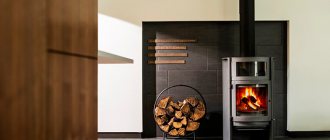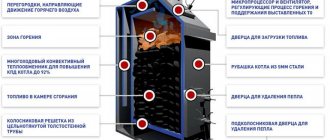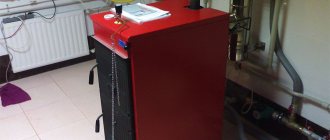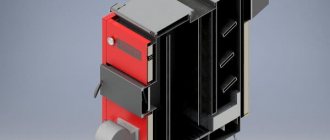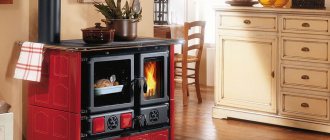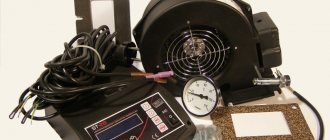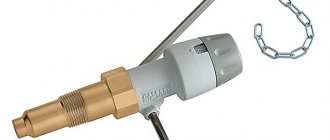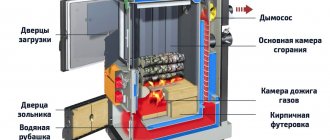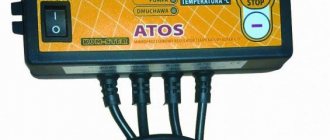Weak boiler power will ruin everything, including the standard of living. Due to excess power, the system will operate in impulses: fuel consumption will increase, and the service life of the equipment will be shortened. The boiler may boil. Or brains. How to calculate correctly, what parameters to take into account, what heat loss is and other customer questions about boiler power can be read here.
How to easily calculate the power of a heating boiler?
You can calculate the approximate power of a boiler for a home by area and volume .
1) A simplified version of calculations by area : 10 kW per 100 m² of a house (or heated area). And this figure will only show the minimum power, below which you cannot fall.
| Graph of boiler versus area |
To take into account climatic zones, coefficients have been developed that correct this formula:
- Central Russia is 1-1.5;
- Northern regions are 1.5-2;
- Southern territories – 0.7-0.9;
- Moscow and Moscow region – 1.2-1.5.
To get closer to a realistic figure, you also need to take into account possible heat loss. To do this, add 10-15% to the minimum value. If the ceilings are higher than 2.7 meters, then we divide the actual ceiling height by the standard height. We get another correction factor.
| Vacation home |
Example:
Let's calculate the power of a boiler for a house in the Moscow region. Ceilings – 3 meters, area – 150 m². A double-circuit boiler is needed - for heat and hot water supply.
The formula gives 15 kW - the minimum power value for the future boiler. Next, to the number 15 we add 10% of heat loss, multiply by the climate coefficient 1.2. The ceilings are higher than 2.7m, so we multiply the resulting figure by a factor of 1.1.
Boiler power = 15 kW (minimum) + 10% (heat loss) * 1.2 * 1.1 = 21.7, rounded to 22 kW.
2) Second formula based on volume : 1 m3 – 40 W. Plus the markups that were included in the first formula, except for the ceiling coefficient. Let's calculate the same house in the Moscow region using this formula.
Boiler power =((150 m²*3m)* 40 W + 10%) * 1.2 * 1.1 =23522 W ≈ 24 kW. The difference between the first and second calculations is 2 kW. The option of calculating boiler power by air volume is the most correct.
You could stop reading this article here. But the difference between an approximate and an exact calculation is in several nuances. What are the nuances, you ask. The answer to this question is contained in the following paragraphs.
Floor models
The new boiler must provide the required heating power and performance of the hot water supply system (DHW). The first value is proportional to the heated area, and the second represents the sum of all water withdrawal points. Both parameters depend little on the heater design. The floor-standing model is chosen due to its low price, lack of strict requirements for pressure stability in gas and water supply systems, and the ability to work without electricity.
The main thing that the consumer expects from a hot water system is that it provides the required performance and a constant temperature of hot water. When choosing a new boiler, factors such as high efficiency, low fuel consumption, long-term operation with water of any chemical composition, and operational safety are also taken into account.
Other characteristics (environmental friendliness, level of automation, ease of operation) are not critically important and are considered secondarily.
Single-circuit gas boilers are being replaced with new units that include water heating. The characteristics of the equipment allow it to be placed anywhere in a living space, without requiring a separate room. Consumers give priority to Russian products because they are more repairable and easier to maintain than imported analogues.
Fondital Madeira Solar KRBS MZ 12
This is a floor-standing, double-circuit 10-kilowatt condensing-type unit, suitable for heating 93 m² of area. It weighs 276 kg and has dimensions of 1857x600x985 mm. Equipped with a built-in boiler and circulation pump. When operating at full power, it consumes 1.27 m³/hour of gas at an inlet pressure of 20 mbar. The designers introduced 2 additional operating modes - “summer” and “warm floor”.
Advantages:
- Efficiency 105% due to the energy of exhaust steam;
- expansion tank 10 l;
- closed combustion chamber;
- boiler with a capacity of 300 l;
- The heating and DHW circuits operate up to 3 and 6 bar, respectively.
Flaws:
- heavy weight;
- high electricity consumption (385 W).
Aton aogvm -10ev/emv
In the documentation for the ATON Atmo 10EB model, the manufacturer indicated a rated power of 10 kW, which is enough to warm up a room of 75 m².
To achieve the declared characteristics, the pressure in the gas pipeline must be at least 12 mbar. The weight of the heater is 46.5 kg. Dimensions are 746x324x610 mm.
Safe operation is ensured by several sensors that monitor:
- overheating of the coolant in any of the circuits;
- gas supply interruption;
- burner flame disappears;
- lack of traction or lack of it.
Advantages:
- the operation of the device does not depend on the availability of electricity;
- the temperature rise of the heated water is Δt=35°C.
Flaws:
- low DHW capacity 4 l/min;
- There is no built-in pump for the heating circuit.
Termomax a 10ev
The gas double-circuit floor-standing boiler develops 10 kW and is supplied in a floor-standing version. Its energy is enough to heat 80 m² and provide hot water.
The weight of the device does not exceed 62 kg. Dimensions (HxWxD) are 760x357x382 mm. In maximum heating mode, fuel consumption is 1.11 m³/hour.
Advantages:
- non-volatile;
- the pressure in the heating circuit does not exceed 3 bar;
- many sensors that monitor emergency situations, such as gas supply cutoff, water overheating, burner extinguishment or lack of draft in the chimney.
Flaws:
- no built-in circulation pump;
- low DHW productivity (at Δt=35°C 4.1 l/min).
"Lemax Premium-10"
In the manufacture of Premium series boilers, high-quality metal of the EN 10130:2006 standard (GOST 16523-97 and 9045-93) with a thickness of 2 mm is used. For greater efficiency, the radiator is given a special shape. Treatment with an inhibitory compound and subsequent coating with anti-corrosion enamel (withstanding temperatures of 750°C) protect the heat exchanger from exposure to aggressive environments when heated.
Thanks to this technology, the radiator operates uninterruptedly at a pressure of 2 bar throughout the warranty period.
Advantages:
- equipped with sensors that ensure safe operation (overheating of the stainless steel heat exchanger, reverse draft);
- remains operational at a gas pipeline pressure of 13 mbar;
- injection burner;
- economical, efficiency is 90%;
- pipes with a diameter of 40 DIN allow you to heat the room due to the natural circulation of the coolant.
Disadvantages of the boiler:
- heavy weight (39 kg);
- open burner type.
What parameters, besides volume and area, influence the choice of boiler? And why is this important?
A simplified calculation formula often leads to the purchase of an unsuitable boiler. Each house is individual, and heat loss percentage cannot be equal for all houses. Before calculating power, consider the data of a specific house:
1) Measure the area of walls, windows, doors;
2) Specify the thickness of the walls, indicate the type of finishing and material, the height of the ceilings;
3) Observe the minimum temperature of the house in cold weather;
4) Determine the desired temperature as a result of installing the boiler;
5) Write down the thermal conductivity values for the materials from which the house was built.
| Wall material | Wall thickness and material thermal resistance | Required thickness for home |
| Brick (1600 kg/m³ - density) | 510 mm (if laying two bricks), R=0.73 °C m²/W | 1380 mm 2190 mm |
| Wooden beam | 150 mm, R=0.83 °С m²/W | 355 mm 565 mm |
| Expanded clay concrete (1200 kg/m³ - density.) | 300 mm, R=0.58 °С m²/W | 1025 mm 1630 mm |
| Wooden panel (inside filled with mineral wool + 25 mm layer of inner and outer cladding) | 150 mm, R=1.84 °С m²/W | 160 mm 235 mm |
| Arbolit | 0.80-0.17W/m² | — |
| Foam concrete | 0.14-0.38 W/m² | — |
| Aerated concrete | 0.18-0.28 W/m² | — |
Thermal resistance of materials
Why is this necessary? The key parameter influencing the choice of boiler is the heat loss of the house. Houses with the same area and volume, but different degrees of insulation, will require equipment of different power.
Where does the heat go:
| Surface | Heat loss in% |
| Roof and ventilation | 20-25% |
| Foundation, if it is adjacent to the ground | up to 15% |
| Walls, windows and doors | 10-15% |
| Ground floor and unheated rooms, basement, for example | up to 15% |
It also matters: how different the outside temperature is from the inside, the climatic region, the strength and direction of the wind, how the house stands relative to parts of the world.
| Heat loss |
Design and design features of the Kholmov boiler
By Kholmov boiler we mean a shaft-type design. This means that the combustion chamber, as well as the section with the heat exchanger, are located vertically in this case. These types of boilers operate on solid fuel, which can also be firewood. The power of industrial models, which can be purchased at specialized retail outlets, is 10, 12 and 25 kilowatts. If the fuel compartment is fully loaded, this can provide continuous heating of an average-sized room within 12-16 hours.
All Kholmov boilers can be of two varieties:
- energy dependent;
- non-volatile.
Now let’s take a closer look at the internal structure of the described heating device. So, it includes the following structural elements:
- frame;
- thermostat;
- fuel mine;
- input/output required for entry, exit and drainage, installation of a safety group or safety valves;
- chamber in which the heat exchanger is located;
- pipe for connecting the chimney;
- grates;
- thermal expansion compensators;
- doors;
- ash pit.
As we see, there are not very many elements. As for weight, for example, a boiler with a power of 12 kilowatts weighs about 255 kilograms. The standard dimensions are as follows (HxWxD): 124x48.5x66 centimeters. For this reason, you will not have any difficulties in bringing such a boiler, say, into a doorway. Models with a power of 10 kilowatts are not much different from those described above (both in parameters and in appearance), but the main difference is in the internal design.
The upper doors of the device are double, and inside there is thermal insulation material (in fact, because of this they do not warm up above 80 degrees). The edges of the doors are covered with asbestos sealant, and special heat-resistant paint is used for painting. There are 4 quick-release screws to close the back cover; everything else is closed using special locks. In addition, the lower door of the ash compartment is only 40 percent closed with thermal insulation material, but its temperature, as a rule, does not exceed 90 degrees, since the element is cooled by permanent air currents.
Important information! The bottom of the chamber is not the lowest part of the heating device. The latter is a special plate with a pair of long legs and a thermal insulator located inside.
Thanks to all this, the Kholmov boiler received not only a fairly high efficiency, but also a sufficient degree of fire safety. As a result, the device can easily be installed even on a floor made of wood.
If we consider specifically the non-volatile models of the Kholmov heating device, then they are additionally equipped with a fan or smoke exhauster, as well as a special controller designed to control the process. However, non-volatile devices are still the most popular. The working process in them is regulated by a special thermostat, which is located on the front wall. This thermostat is connected via a chain to a small blower door.
The door itself is designed to supply air inside the boiler, which is required to maintain the fuel combustion process. Located on the large door of the ash compartment. It never closes completely, since there must be a special gap required for minimal passage of air masses.
At the top of the rear part there is a pipe, and the chimney is connected to it, in turn. This element, by the way, is intended to create natural traction. As a result, air is supplied to the device through the blower door. Behind a pair of cast iron grates (which, by the way, are removable) there is an auxiliary welded grate, which is also called humps, because it is located above a couple of others.
An ash box is located under the grate (ash is collected in it). If the door is open, this drawer can be easily pulled out for subsequent cleaning. The working fluid is drained through a special half-inch pipe, which is located at the bottom of the boiler. A similar element is available for the fuse pipe or safety group. Products for inlet and return are larger in size, the return pipe is located at the bottom, and the outlet pipe is at the top.
Important information! To avoid expansion of the heating device to critical dimensions and divergence of seams, the device contains expansion compensators.
The latter are located around the perimeter of the boiler. In addition, they are in the body - made in the form of partitions/rods. The distance between the dividing walls is 24 centimeters. As for the heat exchanger, the design does not provide for such compensators, since the dimensions of this element allow it to preserve its own shape.
Video - How the Kholmov boiler with a capacity of 25 kilowatts works
How to calculate power taking into account heat loss?
What is heat loss? Let’s say it’s -20 degrees outside, but the average temperature at home is +20 degrees. These quantities are balanced through the exchange of energy. Heat losses occur. The amount of heat loss under severe weather conditions helps to calculate the boiler power with high accuracy.
Step 1
Heat loss is determined by the formula: Q = Q roof + Q walls + Q floor + Q doors + Q windows .
Where the extreme value of Q is the heat loss of each surface of the house.
Each Q value is calculated using the formula: Q = S * T / R
Where Q is heat loss in W, S is the area of a specific surface in m², T is the difference between street and room temperatures in degrees, R is reference data on thermal resistance by type of material.
Step 2
This formula additionally includes involuntary heat loss through cracks, ventilation, exhaust hoods, opening doors and ventilation through windows. For independent calculations without a program, an additional 5% of the total leakage figure is added.
Step 3
Next we move on to determining the boiler power. There are only two formulas to choose from:
Rkot. = ( S room * P beat ) / 10 , where Rkot. — boiler power, Sroom. - the total area of rooms in the house where heating is planned, Pud. — specific power according to climate conditions.
Rkot. = ( Q losses * S from area ) / 100, where Rkot. - boiler power, Qloss - heat loss, Sot. area – total area of heated rooms.
Step 4
For an electric and gas boiler, you can use the table to check:
| Option | House area, m² | Heating, kW | Recommended number of devices | How many people live | DHW boiler, l/kW | Warm floor, m² | Warm floor, kW | Total power | Boiler power | Standard range of boilers, Cat, Ns/A/Nd |
| 1 | 2 | 3 | 4 | 5 | 6 | 7 | 8 | 9 | 10 | 11 |
| 2 | 150 | 19 | 10 | 4 | 100/28 | 16 | 0,75 | 48 | 28 | 28/27/28 |
| 3 | 200 | 22 | 11 | 4 | 100/28 | 20 | 1 | 51 | 28 | 28/27/28 |
| 4 | 250 | 25,5 | 17 | 4 | 160/33 | 20 | 1 | 60 | 33 | 32/35/36 |
| 5 | 300 | 27 | 20 | 6 | 160/33 | 30 | 1,5 | 62 | 34 | -/35/36 |
| 6 | 350 | 31 | 26 | 6 | 200/33 | 40 | 2 | 66 | 39 | -/44/44 |
| 7 | 400 | 4 | 30 | 6 | 200/36 | 50 | 2,5 | 70 | 43 | -/44/44 |
| 8 | 450 | 36 | 44 | 8 | 300/36 | 60 | 3 | 75 | 45 | -/53/52 |
Wall-mounted gas boilers
In this group of equipment, the leading products are from foreign manufacturers. Inside the housing there are not only a standard burner, heat exchanger and monitoring and control units, but also 1 or 2 circulation pumps, an expansion tank, a pressure gauge, a thermocouple, a Wi-Fi module, etc.
Elements of heating and hot water supply systems, assembled in one device, simplify installation. In addition, the installation of a new unit is free of charge, while the connection of other attachments is paid by the buyer. Small dimensions allow it to be placed in any kitchen without disturbing the interior.
Fondital minorca ctfs 9
A double-circuit wall unit heats an area of 74 m². It has the smallest dimensions among the models under consideration (HxWxD) - 700x400x250 mm. Operation is maintained even at low gas inlet pressure. Its nominal value is 20 mbar, at which the fuel consumption is 1.1 m³/hour. The device is equipped with electronic ignition and controls the presence of flame using the ionization method.
Advantages of the model:
- low power consumption from the mains 102 W;
- coaxial chimney;
- high DHW productivity (11.4 l/min);
- separate heat exchangers for heating and hot water preparation;
- summer operating hours;
- selection and equipment of a room temperature sensor;
- closed combustion chamber.
The disadvantages of the model are associated with its small dimensions:
- the pressure in the hot water circuit should not exceed 6 bar;
- low efficiency – 89.9%;
- unit power is less than 9.3 kW;
- reduced temperature limits for hot water and coolant – 62°C and 83°C.
Baxi eco4s 10f
This model of wall-mounted gas boiler belongs to the fourth generation of the series and is distinguished by its compact dimensions (730x400x299 mm), especially its depth. The double-circuit model with a closed burner with a power of 10 kW is easy to install and has good performance. The bright display continuously informs about the current status of the equipment, current settings and system parameters.
The combustion chamber has good performance:
- the microprocessor carries out its gradual ignition;
- the flame is modulated electronically in all modes;
- the unit remains fully operational when the pressure in the gas pipeline drops to 5 mbar;
- the burner is made of a special grade of stainless steel;
- air is supplied to the chamber using a patented method;
- equipment can operate from a liquefied gas source.
Baxi eco home 10f
Double-circuit device with a power of 10 kW with a closed burner for heating rooms of 80 m². It is characterized by small dimensions (HxWxD - 730x400x299 mm) and a weight of 30 kg. The DHW circuit has increased productivity (Δt=25°C) – 13.7 l/min.
The advantages of this model are:
- built-in GRUNDFOS pump;
- modulating burner;
- connection of the “warm floor” system;
- work in summer mode;
- high efficiency 92.9%;
- economical fuel consumption 1.19 m³/hour, the value is given for maximum load;
- increased volume of the expansion tank (6 l).
The disadvantages of the boiler are:
- no remote control unit;
- there is no built-in boiler;
- limitation of the upper limit of coolant temperature 85°C.
Protherm Gepard 12 MTV
The 11.5 kW unit is designed for gas pumped at a nominal pressure of 20 mbar. An atmospheric burner is used. The peak power consumption of electricity is 136 W. The DHW circuit provides 11 l/min. The heated area declared by the manufacturer is 95 m². The coolant heats up to 85°C. For comparison, the Proterm Gepard 23 MTV boiler heats up to 150 m².
Advantages of the boiler:
- high DHW productivity, at Δt=25°C reaches 11 l/min;
- the ability to switch between “Winter” – “Summer” modes;
- microprocessor control;
- “warm floor” support;
- precise power control (saving fuel and electricity consumption);
- built-in expansion tank 5 l;
- high efficiency – 93.2%;
- there is a circulation pump.
Flaws:
- increased fuel consumption – 1.39 m³/hour;
- preparation of hot water only in flow mode;
- The heating circuit heat exchanger is limited to 3 bar.
Equipment protection systems respond to gas supply interruption, water overheating, lack of draft, burner flame going out, coolant freezing and other disturbances in its circulation.
This manufacturer also has a 11 kW double-circuit gas boiler “Proterm Gepard 11 MOV” with an open combustion chamber.
NAVIEN Deluxe-10K
The manufacturer paid attention to service functions such as protection against freezing or overheating. As soon as the coolant temperature drops below 10°C, the circulation pump automatically turns on and thus equalizes it by forced movement. When the reading is less than 6°C, ignition will occur to warm the coolant to 21°C.
When the supply voltage surges, reaching +/-30% of 230 V, the SMPS (Switched-Mode Power Supply) chip is triggered and puts all electronics into safe mode. In this way, breakdown of complex and expensive equipment is prevented.
The owner of a NAVIEN boiler may not even notice a strong drop in pressure in the gas pipeline to 4 mbar, since the equipment will continue to function safely. The same picture is observed when the pressure of the supplied water is reduced to 0.1 bar. These situations are not uncommon in houses located far from main communications.
The wall-mounted gas boiler integrated individual components of the heating circuit. The solution turned out to be in demand by the market, as it reduced the cost of equipment and installation work. The demand for such projects up to 10 kW is constantly growing.
You may be interested in knowing which gas boiler to choose for heating a house of 200 square meters.
Why count if you can buy a boiler with a power reserve?
Sometimes boilers have a capacity reserve. This is good when the reserve is no more than 25%. Especially when the family plans to develop the area: complete a swimming pool, sauna, or other heated area. When the required power is exceeded significantly, the owner spends extra money, and the equipment operates in abnormal mode:
| Boiler repair |
- Breaks or malfunctions;
- The efficiency of the system decreases;
- A higher power boiler costs more;
- More fuel is consumed than is required to heat the house;
- A more powerful and expensive pump will be needed;
- The house will be very hot;
- Automatic regulation becomes difficult, the boiler may boil;
- The boiler begins to cycle - it turns on and off in a short period of time, equipment components wear out;
- Condensation appears in the chimney. When burned, the condensate reacts with the emissions and produces acid. It destroys the chimney and sometimes the boiler.
Conclusion: frequent switching on and off wastes more fuel than continuous operation. Buying a boiler with excess power not only makes no sense, but is also harmful to the budget and equipment.
About the manufacturer
Tt Taimen boilers are produced in the Moscow region by a small company specializing exclusively in the production of a small model range of 4 boilers with a capacity of 6, 10, 20 and 50 kW. Delivery is carried out throughout Russia, but not on our own, but through transport companies.
In general, during its existence on the market, the company has established itself as a manufacturer of trouble-free, practically free, efficient boilers. All models have the same operating principle and design; they differ only in power and dimensions. All boilers are exclusively mechanical; they do not use electronic automation. They work both on wood and on coal, peat, and fuel briquettes. However, the duration of combustion of one load also depends on the type and quality of fuel. According to the manufacturer, combustion lasts from 12 hours, in practice it is 8-12 hours with wood, 12-20 hours with coal, with moderate operation not at the combustion limit, combustion can be achieved for more than 24 hours.
Internal structure using the example of Taimen-10. Combustion occurs in a small area near the grate, and all the resulting gases are burned in the secondary chamber, which increases efficiency and reduces emissions. The rest of the structure consists of traditional elements.
Combustion occurs at the very bottom of the combustion chamber, at the grates and the air supply opening. This not only has a positive effect on the efficiency and duration of combustion, but also reduces emissions of combustion products and smoke outside the combustion chamber. According to operating practice and reviews from owners, neither during the first kindling, nor after years of operation, smoke comes out, although when the loading door is opened, it is blown out into the room in a small amount.
In general, over more than 8 years of operation, no serious malfunctions were identified. The boiler firebox is quite durable, made of 4 mm steel, which is quite good in comparison with many models with only 3 mm, but also does not reach high-quality foreign models with a steel thickness of 5-5.6 mm.
Otherwise, the only disadvantages that can be noted are the noticeable dimensions and, in our opinion, the rather inflated cost of powerful models with a heating capacity of 20 and 50 kW (Taimen-20 and Taimen-50).
How to solve the problem of high power and weak demand?
In an ideal situation, the boiler operates at a constant, rated output. At the same time, the outside temperature is constantly changing, and there are even abnormal jumps. What to do? Four-way mixing valves in the hydraulic system will help. Or an option with thermo-hydraulic distribution. These devices solve the problem not by adjusting the boiler power, but by adjusting the control valve. Or the speed of the circulation pump changes. The temperature of the coolant in the batteries becomes comfortable without disturbing the optimal conditions of the boiler. This solution has a minus - a high price.
| Four way mixing valve |
For gas and liquid fuel boilers, multi-stage burners solve this situation. A lower stage reduces the boiler power if necessary. Advanced models have a smooth adjustment of burner power - modulation. It is cheaper and not as troublesome as the first option.
| Multi-stage gas burner |
Solid fuel boilers also have built-in power settings and automatic fuel supply. This helps solve the issue of excess power when the external temperature changes.
| Automatic fuel supply device for liquid-heat boiler |
Features of the operation of mine boilers
The air enters under the grate and directly into the boiler through the ash door, which is why the fuel is burned. When this happens, flue gases are formed - they are discharged through the gas gap. The Kholmov boiler has such a design that the volume of air supplied through the blower door is initially no longer sufficient for complete combustion. As a result, a certain chemical burn is observed during operation of the device.
In our case, chemical underburning indicates that during oxidation, not pure carbon dioxide is formed, but the same, but in combination with carbon monoxide. The air that passes under the auxiliary grate is drawn into the holes on it. The number of these holes is such that the amount of secondary air is already too much. The heat intensity in this place is quite high and can reach 700-800 degrees, as a result of which the remaining carbon monoxide is oxidized.
Important information! If you look through the peephole, which is located in the rear upper door, you will see that fire is escaping from the holes on the auxiliary grate (yellow or bluish, as when burning gas).
After oxidation, the gas moves to the radiation compartment of the combustion chamber. There it is mixed, rises and is divided into a pair of streams thanks to the exchanger. Then, through the outlet pipe, the gas enters directly into the chimney. Convective thermal energy is absorbed by the exchanger and the walls located next to it. After passing through the inlet pipe, the working fluid, accordingly, hits the wall, after which it spreads and moves through the entire device between the heat exchanger and the chambers. The already heated coolant is supplied to the heating system through the outlet pipe at the top of the device.
Boiler drawing
What happens if you buy a boiler of lower power?
When the owner made a mistake with the power on the smaller side, this is just as bad as an oversupply. The system is working at its limit. Service life is reduced. The house is not heated sufficiently; the system may freeze during abnormal frosts.
| Freezing of the heating system |
Owner reviews of solid fuel boilers Taimen: advantages and disadvantages
| Advantages | Flaws |
| In terms of price-quality ratio, these are some of the best and underrated shaft-type models on the market | Quite a high cost of powerful models of 20 and 50 kW |
| Burning time with wood is 8-12 hours; with coal, boilers produce market average indicators | Large dimensions of all models |
| The large volume of the firebox allows you to load firewood of almost any length, in particular up to 40-45 cm | Delivery to Russian regions is carried out by transport companies |
| Reliability and durability due to relatively thick steel and simple design | |
| Slight soot formation and moderate tar formation; when burning, smoke does not enter the room | |
| Versatility and “omnivorous”, boilers are suitable for burning almost any solid fuel | |
| The cost of models with a power of 6 and 10 kW is extremely budget-friendly for this type of boiler. |
Why contact a specialist?
We found out that buying a boiler from the square is wrong. It is important to consider the heat loss of the building. For example, a house of 300 m² can be heated by a 15 kW boiler if all surfaces are thoroughly insulated. And a house of 150 m² may require 30 kW equipment with thin walls and uninsulated roof and ventilation.
There are hundreds of standards and regulations on this topic, there are dozens of formulas. Sometimes one thing contradicts the other, or standards change and it is difficult for a non-professional to understand whether these requirements are relevant. You can calculate all this armed with a stack of reference books. Or contact specialists who will make accurate calculations in the program and explain all the details. They will help you save money, time, and model an efficient home heating system.
